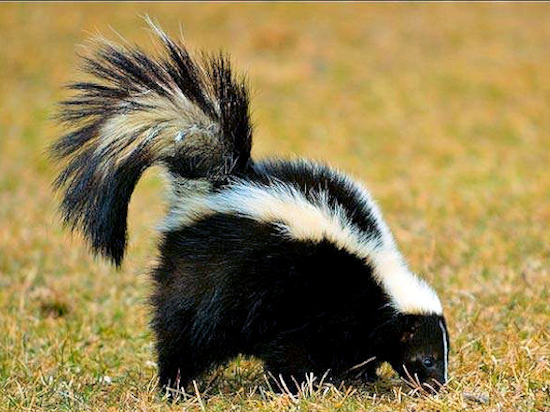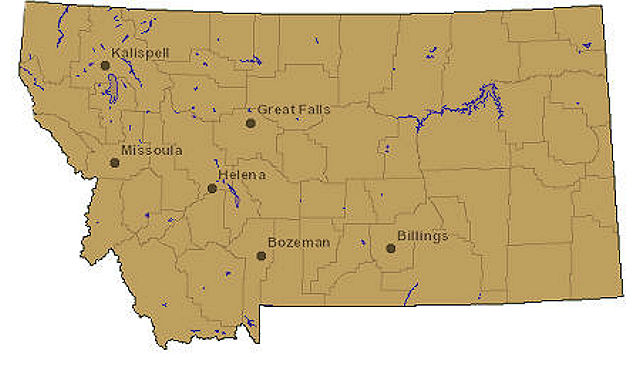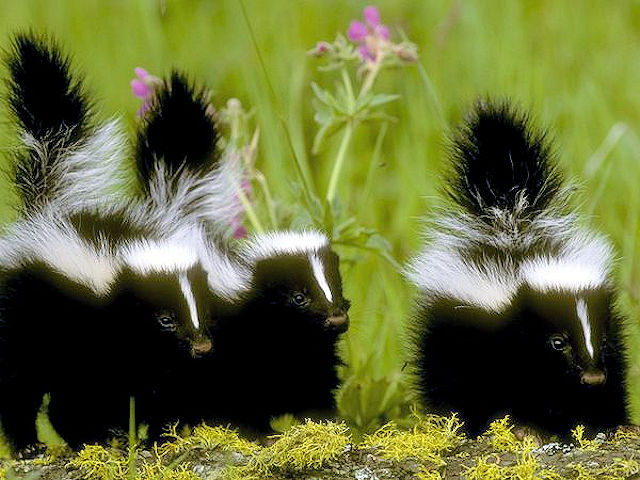Striped Skunk

Mustela mephitis
Order:
Carnivora
Family:
Mustelidae
Status: Nationally a valuable fur animal. Individual pelts are not very valuable but tremendous numbers are taken. Very abundant nongame animal.
Identifying Characteristics: About the size of a house cat. Well-developed scent glands that emit a very strong odor. Often the presence of a skunk is first detected by its odor. Black body, narrow white stripe on middle of the forehead, broad white area on nape that usually divides into a V at the shoulders. Great variation in color pattern and size of stripes.
Total length: 20 to 28 inches. Weights: 6 to 14 pounds.
Habitat: Lives in a variety of habitats including semi-open country, mixed woods, brushland, and open prairie. Most abundant in agricultural areas where there is ample food and cover. Usually absent where water table is too high for making round dens.
Food Habits: An opportunistic, omnivorous, predatory feeder. Consumes mice, insects, eggs, berries, and carrion. Diet varies greatly depending on season and geographic location. From November through April, when food is scarce or unavailable, skunks spend extended periods in their dens.
Life History: Mostly nocturnal and does not hibernate. Uses ground burrows, abandoned or occupied building foundations, and wood or rock piles as den sites. Will use dens created by other animals. When frightened or threatened, sprays a strong and long-lasting musk produced by anal scent glands. Mating occurs during February and April; 59 to 77 days gestation; may exhibit delayed implantation; young born during May or June; 5 to 6 young is the usual litter size.
Similar Species: A few specimens of the spotted skunk have been captured in Montana. The spotted skunk has a black spot on forehead, one under each ear, and four broken white stripes along neck, back, and sides.
The Latin word "mephitis" translates to "bad odor", and many people would agree that the name "bad odor - bad odor" aptly fits the common and abundant striped skunk.
Smaller spotted skinks are also distributed widely, and two species are recognized. Known as "civets" to the fur trade, the western spotted skinks experience a delayed implantation reproduction, while the eastern skunks do not. All species of skunks are attracted to a wide variety of baits, and they are frequently caught in traps set for other species.
 Description
Description
Average adult striped skinks weigh 6 to 8
pounds, although body weight might be
significantly heavier in late fall as the skunks
attain layers of fat to sustain themselves
through winter. Spotted skunks are much smaller,
usually weighing 2 or 3 pounds. Males of both
types are slightly heavier than females.
All striped skunks have a white stripe on the head between the nose and the forehead. A white crest, or cap, is typical on the top of the head, and a continuing white stripe usually divides over the shoulder area into two stripes that continue along the sides of the animal into the tail. The amount of white coloration varies with the individual skunk, with some having broad stripes, narrow stripes, short stripes or even none at all.
Spotted skunks have a white patch on the forehead area, and a broken pattern of white striping that appears as blotches or spots of white in the otherwise black fur. The amount of white also varies with individuals. Some spotted skunks have mostly black tails while other can be mostly white.
The scent glands in skunks are well developed. Musk, or essence, can be sprayed repeatedly as a defense. The yellowish compound is powerful in all skunks, and contains sulfuric acid which can cause temporary blindness in both other animals and man.
Striped and spotted skunks have 5 toes on each foot. The front feet have relatively long claws to assist them in digging for grubs and other foods. Both skunks have 34 teeth, including 4 pointed and sharp canines teeth.
Skunk fur is rather long, and longer on tails than on bodies. Underfur is white under the white guard hairs, and grayish under the black colored guard hairs.
 Reproduction
Reproduction
Striped skunks often breed during
February, and the males do a great deal of
traveling at this time to locate females. Many
times, females will live in an underground den
through the winter with only one male, who will
protect the communal den from invasion by
another male.
Gestation periods are usually 63 days, and all bred females seek solitary dens to raise their young by themselves.
Litter sizes of striped skunks are usually 6 to 8, except for the first litter, which usually numbers 4.
The eastern species of spotted skunk, Spilogale Putorius, usually breed in April. Gestation is about 60 days before 3 to 5 young are born.
The western species, Spillage Cracilus, breeds in September or October and gestation is about 140 days due to a delayed implantation process.
The litter of striped and spotted skunks begin following their mothers at 6 weeks of age. Travel is often single file, and the young are quick to learn to find grubs and insects.
The family unit breaks up as the young reach 3 months of age. Dispersal is not significant, and the juvenile females may continue to share their mother's den. Males are evicted, however, by the dominant male, and the juvenile male skunks are forced to find other suitable den locations.
Habits
Striped skunks are mostly nocturnal,
doing most of their hunting and traveling during
the night. Territory sizes are somewhat small,
and overlapping or sharing of territories is
normal as the species does not defend it's
territory against others of the same species as
do some other species. Home ranges are
considered to be about 4 square miles, but most
skunks do not travel more than a mile or so in
one night's activity.
Communal dens are common during the time of year that young are not being raised, and 6 to 20 skunks might share a den with one male at a time.
Striped skunks suffer from poor vision at a distance of more than 2 or 3 feet. A keen sense of smell enables then to easily locate foods, which vary with the season. Not a particularly swift animal, skunks don't need good distance vision to locate prey species which have little or no mobility. The ability to see a predator at a distance is not necessary either, as the threat of spraying its musk will usually deter all but ignorant predators, who soon receive a lesson.
Skunks usually give ample warning before they spray their musk. Spraying is a defense mechanism and used only when the animal feels that it is necessary to protect its own life. Warnings usually include a lifting of the tail, a turning of the back towards the danger, and sometimes, a pounding of the front feet in a drummer-like fashion.
Spotted skunks are more agile than striped skunks. Their territory sizes are similar to striped skunks. This species can climb very well, and they descend trees head first.
When threatened, spotted skunks commonly do handstands, balancing on their front feet while they lift their bodies into the air. This balancing act usually lasts for about 5 seconds at a time. The species can spray an offender from this position.
Spotted skunks are almost strictly nocturnal, usually retiring to a den before daylight, and coming out only after dark in the evening.
Skunks are not true hibernators, but both species may spend weeks at a time in dens during cold temperatures and deep snow conditions. Striped skunks usually utilize underground dens that have been made by badgers, groundhogs or foxes. At times, they will tolerate other species in its den, even curling up and sleeping with a raccoon or opossum.
Spotted skunks prefer dens under or in old buildings. Oftentimes, a den will on the second floor of an old barn. Dens in haylofts are common, and the spotted skunks easily climb to the elevated areas.
Slow and poorly sighted furbearers, striped skunks are opportunistic feeders. Grubs and insects are commonly located and dug out of the ground, along with juvenile mice, rabbits, and ground nesting birds or eggs found. Fruits and grains are eaten when available, and carrion is commonly eaten during the winter months when many foods are not available.
Spotted skunks are more efficient than striped skunks as predators. These smaller skunks kill and eat significantly more mice and rats. Spotted skunks also frequent the edges of streams and ponds, and they do wade shallow water in pursuit of crayfish, a preferred food.
General
Although skunks are not well liked by
people, they do provide valuable services by
controlling significant numbers of injurious
insects in the larval stages. The diet of
spotted skunks is almost entirely beneficial to
man. Both striped and spotted skunks can raid
chicken houses. The worst offender is usually
the spotted skunk because it can climb easily to
gain access.
Spotted skunks do dig up lawns in pursuit of grubs, and this is an annoyance to those who spend time and money to groom lawns.
The concern of Rabies in striped skunks is very real. More striped skunks than all other species combined are tested positive for rabies every year, and this disease is always a threat to livestock, pets and man.
Striped skunks can destroy a significant number of waterfowl nests. However, recent studies indicate that they may be beneficial to waterfowl populations because skunks are the only significant predator of a far more serious waterfowl, the snapping turtle. Striped skunks relish snapping turtle eggs, which are commonly found, unearthed and eaten.
Six years of age is considered old for either a striped or spotted skunk.